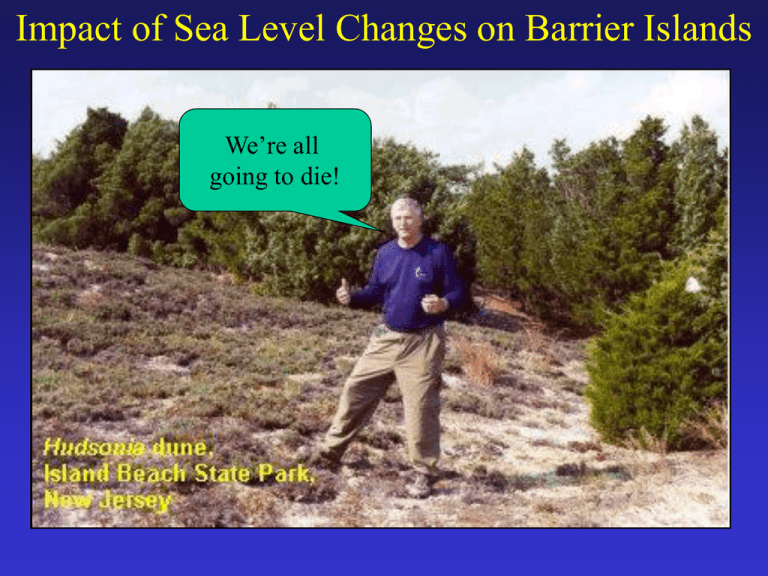Presentation - People Server at UNCW
advertisement

Impact of Sea Level Changes on Barrier Islands We’re all going to die! The Myth of Sea Level Rise and Global Warming “Even if the polar ice caps melted, there would be no rise in ocean levels... After all, if you have a glass of water with ice cubes in it, as the ice melts, it simply turns to liquid and the water level in the glass remains the same." The Reality of Sea Level Rise and Global Warming Excellent theory...... The only problem is Antarctica is a CONTINENT with large quantities of ice on top of it. When the ice melts, new water will enter the ocean. The History of Sea Level Rise • Throughout history, sea level is constantly rising and falling because of the glacial and interglacial periods • Currently we are in a state of sea level rise History cont’d... • Major changes in Quaternary period • In the past 20,000 the sea level has oscillated 130m • Since human occupation of coasts, sea level has risen less than 3 m Recently • Recently on the coasts we are seeing a general rise in sea level of 3-4mm/yr • Mississippi delta region is seeing a 9mm/yr rise resulting in 40 acres land lost/month Sea level is never a constant over space and time Variations in sea level may be local or regional: 1) Atmospheric pressure and winds 2) Freshwater discharge from rivers 3) Ocean Currents 4) Geophysical conditions The Pacific Ocean is approximately 1 meter higher than the Atlantic Ocean Sea level rise is also never consistent and not accurate because it is measured by tide gage data. This date is not evenly distributed, it is measured near population centers where the data is skewed Causes for Sea Level Rise • Tectonic Activity • Subsidence • Isostacy • Eustatic Plate Tectonics • Upheaval and subsidence of plates • May be local or regional and may be sudden or gradual • Volcanic eruptions and faulting Subsidence Withdraw of fluids from pore space in the sediment which therefore causes it to collapse Subsidence • Local rise in sea level based of fluid removal and compaction • Construction of oil wells and drainage of aquifers • Construction of high rises and discharge of sediment loads in the Mississippi Valley Delta (ie. New Orleans) • 6-7 mm of the 9-10mm/yr rise in Mississippi delta is dues to subsidence Isostacy Equilibrium condition of the earth’s crust due to balancing In other words... • Looking at the earth’s surface and the forces on it • Some forces want to push up (elevate the lithosphere) while some want to push down (depress the lithosphere) Isostacy • Volume of water remains the same, land rises or falls because of weight of ice sheet • Glacial compaction and rebound Weight of glaciers on plates depress the the lithosphere 100’s m forming a peripheral bulge Isostacy cont’d • Subsequent melting of glaciers cause the land to rebound • Causes bulge to move back to original shape 1) 3) 2) 4) Eustatic Global change in sea level based on changes of the volume/density of water. The relative position of land does not change Eustatic cont’d • Related to the climate and the shape changes in the holding capacity of the oceans basins 1) Melting of polar ice caps 2) Thermal expansion of the oceans (biggest factor) With an average water column of 3000 m and a basin that stays the same, the sea level could rise by 60 cm for every degree of warming What causes thermal expansion? • Global warming which is caused by the introduction of CO2 into the atmosphere • Estimates indicate an increase in greenhouse gases, temperature and sea level rise. Predict a temperature rise of 1.5C to 4.5C for CO2 alone and as much as 3-9C for all gases. Why do we care? •Shoreline Retreat •Flooding •Saltwater Intrusion Shoreline Retreat For every unit of sea level rise, the high water mark increases by 1000x that distance 80% of the population of the United States lives within 100 miles of the coast The Bruun Rule. Beaches follow a characteristic profile shape based on the wave climate and the types of sediments. When sea level rises, the initial effect is inundation; but eventually enough material will be deposited offshore to re-establish the profile at the higher elevation. Thus, the shore retreat will be based on the slope of the entire beach profile, which is usually flatter than the slope just above the shore. Flooding 1) Because of the effects of sea level rise, a one meter rise in sea level will allow 15-year storm to flood areas that would only previously be flooded by a 100-year storm 2) Beach erosion would leave coastal infrastruction more vulnerable to storm waves 3) Coastal drainage would be reduced, increasing the impacts of coastal rainstorms 4) Finally, a rise in sea level would raise water tables Saltwater Intrusion 1) Increased sea level would allow further penetration of saltwater up rivers, bays, estuaries and aquifers 2) This would harm plants and animals not adapted to salt or brackish waters 3) Contamination of aquifers would threaten human uses of potable waters Possible Impacts of Sea Level Rise for the Atlantic Coast Responses to Sea Level Rise 1) Protection by hard structures and coastal armoring 2) Strategic Retreat 3) Beach Renourishment 4) Elevating Roads and Structures Bulkheads and Levees Expensive process that can cost between $130-$500 per linear foot Wave action into bulkhead projects energy downward, actually increasing erosion seaward of the bulkhead Bulkhead and other hard structures are illegal in some states Sea Bright, New Jersey Strategic Retreat Relocation of property away from eroding beach Paul Foster’s house on Figure 8 island, approximately $25,000 to relocate a house. Price may seem high, but it protects investments of millions of dollars Not all houses can be moved Amount of relocation space is finite, erosion may still destroy the house Beach Renourishment Relocation and addition of beach quality sand from source destination to eroding beach Beach renourishment projects have the potential to be very costly (~$3-$4 a cubic yard) Beach renourishment is not permanent and will require additional renourishment within a couple of years. Before After Elevation of Roads and Houses Extremely expensive alternative that will not stop the rise of sea level. Was used in Galveston, TX at the turn of the century, as a response to hurricane flood damage. Estimated Cost of Coastal Protection in the United States 270-475 billion dollars Remember...... We’re all going to die! http://www.epa.gov/globalwarming/publications/impacts/sealevel/barrier_islands.html http://www.erols.com/jtitus/Holding/NRJ.html http://www.nap.edu/books/0309037816/html/40.html http://www.greenpeace.org/~climate/arctic99//reports/seachange.html http://www.uncwil.edu/people/hosier/CMGMT/SeaLevel.htm http://www.edf.org/programs/GRAP/hotny/ Rising Seas, Coastal Erosion, and the Takings Clause: How to Save Wetlands and Beaches Without Hurting Property Owners – Maryland Law Review, Volume 57, 1279-1399 (1998). The Risk of Sea Level Rise: A Delphic Monte Carlo Analysis in which Twenty Researchers Specify Subjective Probability Distributions for Model Coefficients within their Respective Areas of Expertise – Climatic Change, 33: 151-212 (1996). The Probability of Sea Level Rise – U.S. Environmental Protection Agency, #EPA 230-R-95-008 (1995).







![PERSONAL COMPUTERS CMPE 3 [Class # 20524]](http://s2.studylib.net/store/data/005319327_1-bc28b45eaf5c481cf19c91f412881c12-300x300.png)